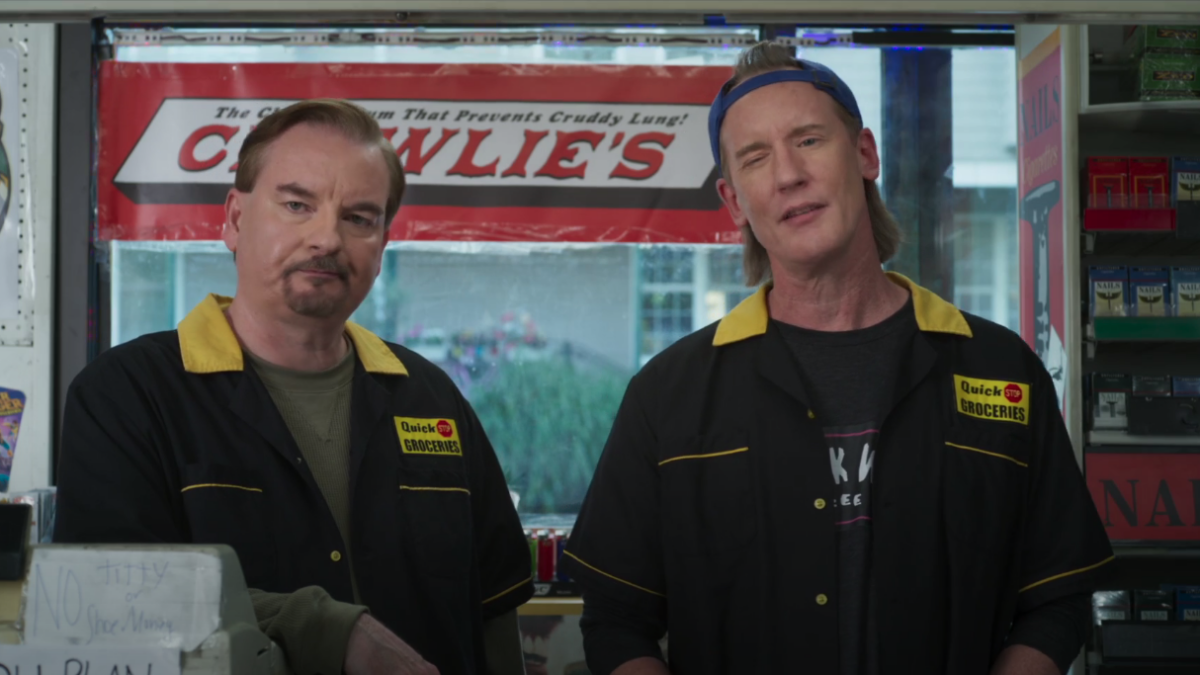“Clerks III,” the final installation in filmmaker Kevin Smith’s “Clerks” franchise, was recently released nationwide in select movie theaters. Smith is slated to continue producing and releasing content in the View Askewniverse (the larger cinematic universe in which “Clerks” is contained); nevertheless, “Clerks III” was a heartfelt and moving goodbye to a franchise that parallels the lives of the audience, which came of age with the franchise.
For those unable to find a screening of the film near them, it is currently available as a digital preorder on Amazon Prime Video. It will be released for streaming in mid-October.
“Clerks,” the first installment in the eponymous franchise, said to be a very loose retelling of Dante’s “Inferno,” was released in 1994 with shockingly large success. Having been produced on a budget of roughly $30,000, “Clerks” made more than 100 times that at the box office and is one of the films credited with kicking off the independent movie craze, subsequently solidifying its status as a cult film classic. The Library of Congress even entered the movie into the National Film Registry for being “culturally, historically or aesthetically” significant in its portrayal of the U.S.
‘Clerks’ and ‘Clerks II’
“Clerks” was a successful, influential, and surprisingly intelligent film as it chronicles the daily life of young men who perpetually experience existential dread and confusion as they wander about aimlessly in their dead-end jobs, yearning for something more out of life.
The film follows convenience store worker Dante Hicks and his best friend, video store employee Randal Graves, as they go through the day slacking off from work, pondering the human experience, bickering, and cracking jokes about fellatio while being visited by a cast of mildly infuriating personalities during working hours.
Among other things, the film chronicles the lives of young men as they do what young men do.
Its sequel, “Clerks II,” released in 2006, is set 10 years after the first film. “Clerks II” had a much larger budget of $5 million and a more robust commercial release, which grossed the film just under $27 million.
This sequel follows Dante and Randal as they are forced to begin new careers after Randal accidentally burns down their former places of work. Dante’s personal life falls apart as he falls in love with his new boss Becky, cheats on his fiance with her, and subsequently impregnates her. He and Becky fall in love, and despite his and Randal’s foibles, the two are able to set aside their insecurities and agree to go into business together.
Whereas the first film told the story of the listlessness of living an aimless existence, “Clerks II” highlights what happens once people begin to take responsibility for their lives, exert agency, and take steps to realize their potential.
‘Clerks III’
“Clerks” tells the story of young men, and “Clerks II” is the story of those men growing up. So, naturally, “Clerks III” shows us what happens when men who are grown begin to grow old.
In 2018, Smith, now in his 50s, suffered what is known as a “widowmaker heart attack.” Allegedly, in 80 percent of cases like Smith’s, the patient dies. Faced with his own mortality and a passion for telling more stories, Smith made a full recovery and went on to continue making movies.
“Clerks III” takes a good deal of inspiration from Smith’s own life in this regard. The film’s plot is set in motion after Randal suffers a widowmaker heart attack, causing him to buckle down and get serious about his passion to share his life story via film.
The film, a retrospective of Randal’s life, essentially is a retelling of the first “Clerks” movie. Having to relive these memories while dealing with immense ingratitude from Randal for his help causes Dante to further reminisce as he recalls the death of his lover and the mother of his never-to-be-born child, Becky, that happened off-screen at some point between the two movies.
The sadness and frustration harm Dante’s health, and he, too, suffers a heart attack.
Randal visits Dante to show him an early copy of the film as Dante realizes he had a life well lived and passes on to be with Becky in the afterlife.
End of an Era
The first two installments in the franchise are explorations of coming of age, while the third shows what happens when we are of age.
Smith’s brush with death is crucial to the message of “Clerks III.” Time flies; remember you will die, so live your life well and cherish the people around you.
There are nearly 30 years that separate the first and the final “Clerks” films. People who were old enough to see it in theatres in the mid-’90s are now, at the youngest, nearing their 50s. Most of them probably have screwed around while on the job, and most have probably lost people they love, similar to how Dante lost Becky and how Randal lost Dante.
What makes “Clerks” such an endearing franchise isn’t the oral sex jokes, the cameos of Smith’s celebrity friends, or Randal’s unceasing sardonic irony. What makes these movies special is that we all share the experiences of Dante and Randal at some point in our lives.
At some point, we’ve been bored; at some point, we’ve been in love; and at some point, we’re going to die.









